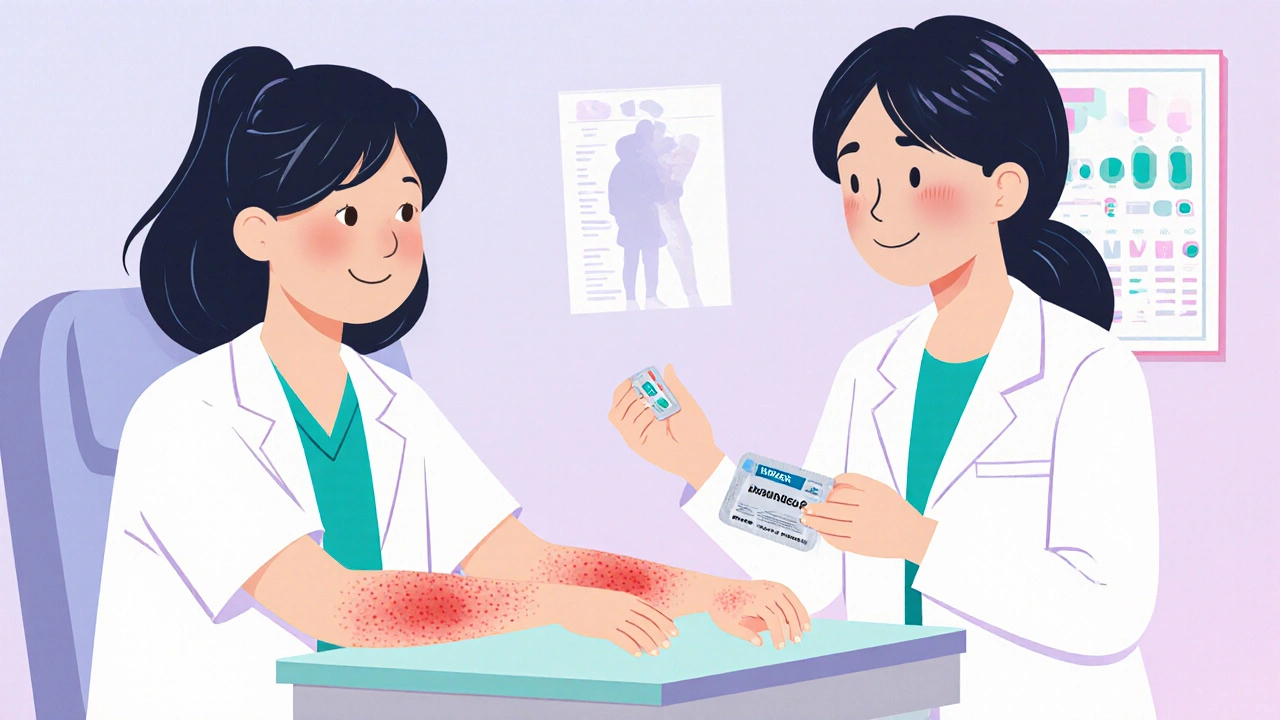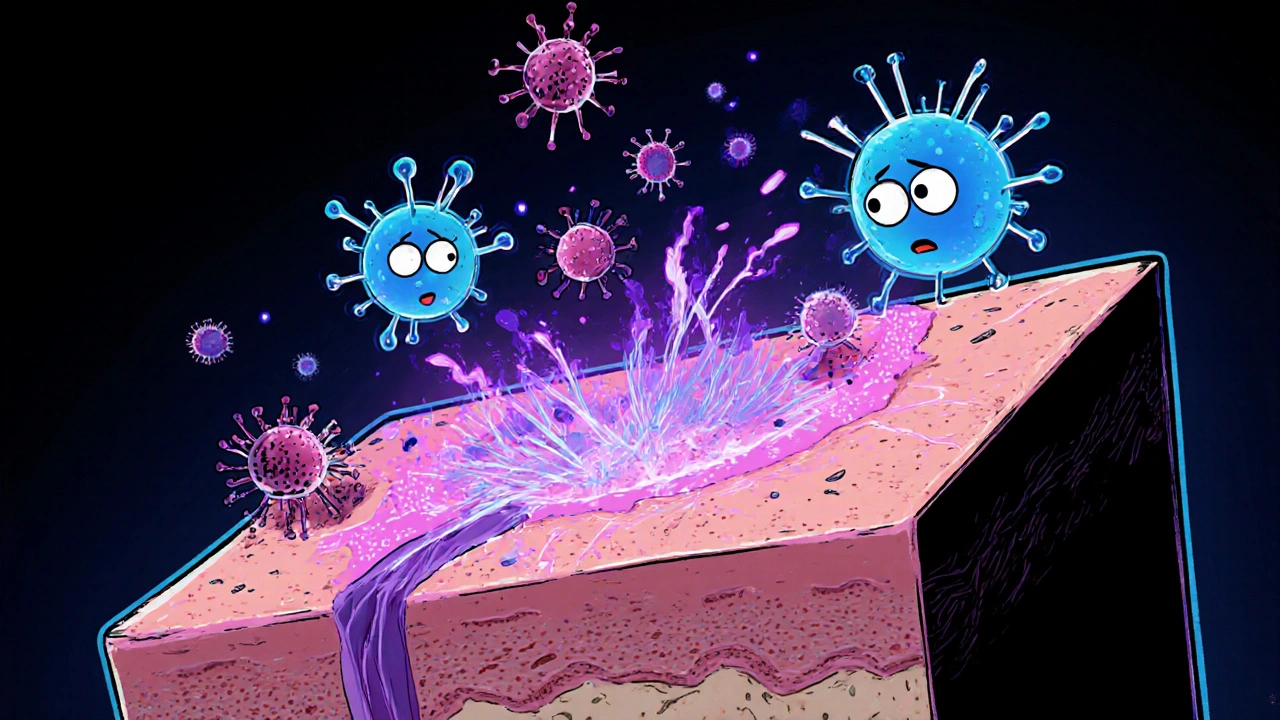
Dapsone Dosage Calculator for Dermatitis Herpetiformis
Enter your current dose and symptom status to see your recommended next dose and monitoring schedule.
Key Takeaways
- Dapsone is the first‑line drug for dermatitis herpetiformis (DH) and works by suppressing neutrophil activity.
- Start low (50 mg daily) and increase gradually; most patients need 100 mg‑200 mg per day.
- Common side effects include hemolysis, methemoglobinemia, and G6PD‑related anemia - regular lab checks are a must.
- A strict gluten‑free diet treats the underlying celiac disease and reduces reliance on medication.
- When dapsone is intolerable, alternatives such as sulfapyridine, methotrexate, or short‑course steroids can be used.
Dermatitis herpetiformis (DH) is a chronic, intensely itchy skin rash that almost always signals an underlying gluten‑sensitive enteropathy. While a lifelong gluten‑free diet tackles the root cause, patients need a fast‑acting drug to calm the rash. That’s where Dapsone a sulfone antibiotic with anti‑inflammatory properties, originally approved for leprosy, has become the gold‑standard treatment for DH. This article walks through how dapsone works, how to dose it safely, what side effects to watch, and which backup options exist when dapsone can’t be used.
How Dapsone Controls the Rash
DH lesions are driven by IgA antibodies that deposit at the dermal‑epidermal junction and recruit neutrophils. When activated, neutrophils release enzymes that damage the skin, creating the characteristic vesicles and papules. Dapsone inhibits neutrophil chemotaxis and reduces the oxidative burst that fuels inflammation. By dampening this response, the drug brings rapid itching relief-often within 48‑72 hours-while the gluten‑free diet works on the longer‑term autoimmune trigger.
Starting and Adjusting the Dose
Because dapsone can cause blood‑related toxicity, clinicians follow a cautious titration schedule:
- Day 1‑7: Begin with 25 mg-50 mg once daily.
- Week 2‑3: If tolerated, increase to 100 mg daily.
- Week 4 onward: Adjust in 25 mg increments up to a typical maintenance range of 100 mg‑200 mg per day.
Most patients achieve symptom control at 100 mg, but some need 150 mg-200 mg for complete clearance. The goal is the lowest dose that keeps the rash quiet.
Monitoring for Safety
Dapsone’s benefits come with a strict monitoring plan. The two biggest red flags are hemolysis and methemoglobinemia, both tied to the drug’s oxidation of red blood cells.
- Baseline labs: CBC with differential, reticulocyte count, liver function tests, and a G6PD screen.
- First month: CBC every 2 weeks.
- After stabilization: Monthly CBC for the next 3 months, then every 3 months indefinitely.
If hemoglobin drops more than 2 g/dL or methemoglobin exceeds 5 %, dose reduction or temporary discontinuation is advised.
Special Considerations: G6PD Deficiency and Other Risks
Individuals with glucose‑6‑phosphate dehydrogenase (G6PD) deficiency are at higher risk for severe hemolysis. A quick point‑of‑care G6PD test before initiating therapy can prevent a dangerous situation. For those who test positive, clinicians usually skip dapsone entirely and move straight to alternative agents.
Other notable adverse effects include:
- Peripheral neuropathy (dose‑related, improves after dose reduction)
- Hypersensitivity syndrome - fever, rash, eosinophilia; stop drug immediately
- Darkening of urine (due to harmless metabolites, but can alarm patients)
Patient education is crucial: tell them to report any new yellow‑brown urine, worsening fatigue, or shortness of breath right away.

Alternative Therapies When Dapsone Isn’t an Option
While dapsone works for > 80 % of DH patients, about 10‑15 % need a backup plan because of intolerance, contraindications, or pregnancy.
The most common substitutes are:
- Sulfapyridine a sulfonamide with a similar anti‑inflammatory profile to dapsone but a higher incidence of gastrointestinal upset.
- Methotrexate an antimetabolite that suppresses immune activity; useful in refractory DH or when a patient also has arthritis.
- Short courses of systemic corticosteroids (e.g., prednisone 20 mg daily for 2‑4 weeks) to bridge the gap while switching medications.
Each alternative carries its own monitoring demands-methotrexate requires liver enzymes and renal function checks, while sulfapyridine still needs CBC surveillance.
Gluten‑Free Diet: The Underlying Therapy
DH is a cutaneous manifestation of Celiac Disease an autoimmune disorder triggered by gluten that leads to villous atrophy in the small intestine. A strict gluten‑free diet (GFD) reduces IgA deposition over months to years and can eventually allow dose tapering or even discontinuation of dapsone.
Key dietary steps:
- Eliminate all wheat, barley, rye, and triticale.
- Read labels for hidden gluten (e.g., modified food starch, malt flavoring).
- Work with a dietitian to ensure adequate fiber, iron, and B‑vitamins.
Serum IgA‑tissue transglutaminase (tTG) antibodies typically fall to normal levels within 6‑12 months on a GFD, signaling that the intestinal trigger is under control.
Diagnosing and Confirming DH
A definitive diagnosis rests on two tests:
- Skin biopsy for direct immunofluorescence detects granular IgA deposits at the dermal papillae, the hallmark of DH.
- Serologic testing for anti‑tTG IgA and endomysial antibodies, which are positive in most DH patients.
Both tests help differentiate DH from other itchy dermatoses like bullous pemphigoid or eczema, ensuring the right treatment pathway.
Practical Follow‑Up Schedule
After the initial titration phase, a typical follow‑up plan looks like this:
- Month 1: Review rash improvement, check CBC, and assess neuropathy symptoms.
- Month 3: Repeat CBC, liver enzymes, and discuss adherence to the gluten‑free diet.
- Month 6: Evaluate serology (tTG IgA) to see dietary impact; consider lowering dapsone if antibodies are undetectable.
- Yearly: Full skin exam, CBC, and dietary counseling.
Patients who achieve complete rash clearance and normalized serology may try a gradual dapsone taper-usually 25 mg reductions every 4 weeks-while staying vigilant for flare‑ups.

Comparison of First‑Line and Alternative Therapies
| Drug | Mechanism | Typical Dose | Onset of Symptom Relief | Common Side Effects |
|---|---|---|---|---|
| Dapsone | Inhibits neutrophil chemotaxis & oxidative burst | 50‑200 mg daily | 48‑72 hours | Hemolysis, methemoglobinemia, neuropathy |
| Sulfapyridine | Sulfonamide anti‑inflammatory | 500‑2000 mg divided daily | 3‑5 days | Gastro‑intestinal upset, rash, hematologic changes |
| Methotrexate | Folate antagonist suppressing immune cells | 7.5‑25 mg weekly | 2‑4 weeks | Liver toxicity, pulmonary fibrosis, mouth ulcers |
Tips for Patients on Dapsone
- Take the pill with food to lessen stomach irritation.
- Stay well‑hydrated; dehydration can worsen hemolysis.
- Carry a medical alert card noting dapsone use and G6PD status.
- Schedule blood work before each dose change and at regular intervals.
- Report any sudden dark urine, shortness of breath, or unexplained fatigue immediately.
When to Seek Specialist Care
If rash persists despite maximum dapsone dose, or if side effects become severe, refer to a dermatologist or a gastroenterologist experienced in celiac disease. Joint management ensures both skin and intestinal health are optimized.
Frequently Asked Questions
How quickly does dapsone work for DH?
Most patients notice a marked drop in itching and fewer new blisters within 48‑72 hours of starting therapy.
Can I stop dapsone once my rash clears?
Only under doctor supervision. A gradual taper over weeks‑months is recommended, especially if serology still shows active celiac disease.
What is the safest way to test for G6PD deficiency?
A quantitative enzymatic assay performed on a fresh blood sample is the gold standard. Point‑of‑care rapid tests are acceptable for screening.
Is a gluten‑free diet enough without medication?
For most patients, the diet alone takes months to years to control the rash. Dapsone provides rapid relief while the diet works on the underlying trigger.
What labs do I need while on dapsone?
Baseline CBC, reticulocyte count, liver enzymes, and G6PD status. Follow‑up CBC every 2 weeks for the first month, then monthly for three months, and every three months thereafter.
Understanding how dapsone fits into the broader management of dermatitis herpetiformis helps patients and clinicians strike a balance between fast symptom control and long‑term safety. With careful dosing, regular monitoring, and a commitment to a gluten‑free lifestyle, most people achieve clear skin and a good quality of life.
15 Comments
Write a comment
More Articles

How to Create a Food and Medication Interaction Checklist at Home
Create a simple, personalized food and medication interaction checklist to prevent dangerous reactions. Learn what foods to avoid with common meds like warfarin and statins, how to update it, and where to keep it for maximum safety.

Tacrolimus Neurotoxicity: Understanding Tremor, Headache, and Blood Level Targets
Tacrolimus neurotoxicity causes tremor, headache, and brain fog in 20-40% of transplant patients-even when blood levels are normal. Learn how genetics, electrolytes, and drug interactions affect risk, and what you can do to manage it.

Ampicillin and biofilms: Can it help break down bacterial communities?
In my latest research, I came across an interesting topic about Ampicillin and its potential role in breaking down bacterial communities known as biofilms. Biofilms are notorious for their resistance to antibiotics, making infections difficult to treat. Ampicillin, a widely used antibiotic, has shown some promise in disrupting these communities. Studies have suggested that it could weaken the biofilm structure, making it easier for other antibiotics to penetrate and eliminate the bacteria. It's fascinating to think that a common antibiotic like Ampicillin might be the key to tackling these stubborn bacterial communities!
Christa Wilson
October 22, 2025 AT 19:00Wow, this guide on dapsone is super helpful! 😊 It breaks down the dosing steps nicely so newbies won’t get lost. The reminder about G6PD testing is especially important – safety first! Also, kudos for emphasizing the gluten‑free diet; that’s the real long‑term hero. Keep up the clear writing, it really eases the anxiety for patients. 🌟